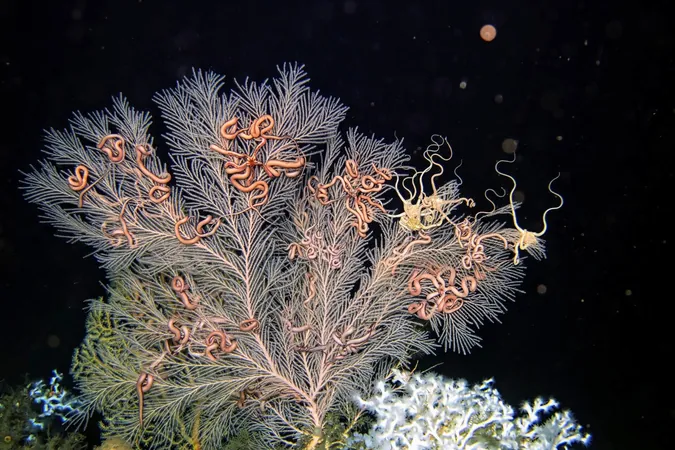
Could Spider Stellar Engines Propel Us Through the Galaxy?
2024-11-13
Author: Siti
Introduction
In a universe teeming with possibilities, the concept of a "spider stellar engine" capable of relocating binary star systems across the galaxy offers a tantalizing glimpse into the future of interstellar migration for advanced civilizations. As stars evolve, their habitable zones shift, prompting the eventual need for any long-lived technological civilization to seek refuge in a different star’s vicinity.
The Concept of Stellar Engines
But how could extraterrestrial intelligences (ETIs) leverage stellar phenomena to facilitate their migration? At the heart of this hypothesis lies the idea of a stellar engine, which harnesses the immense energy of a star. While we often think of solar panels converting sunlight into electricity, a stellar engine takes this concept further—potentially using the star itself to produce thrust powerful enough to move the star.
Historical Background
This notion dates back to early 20th-century science fiction, gaining traction through the work of astronomers like Fritz Zwicky, who envisioned manipulating celestial bodies. Fast-forward to modern research led by Clement Vidal from Vrije Universiteit in Brussels, who explores the feasibility of using binary star systems—specifically "spider pulsars"—as stellar engines in his recent paper, “The Spider Stellar Engine: a Fully Steerable Extraterrestrial Design?”
Binary Star Systems and Spider Pulsars
Vidal posits that approximately half of our galaxy's stars exist in binary systems where life could potentially flourish. His research focuses on a unique subclass of binary stars—spider pulsars—where a rapidly spinning neutron star sheds material from a low-mass companion, akin to a spider weaving a web. This process creates an environment ripe for advanced civilizations to manipulate in the pursuit of interstellar travel.
Technical Signatures and Observable Outcomes
His examination of the technical signatures left behind by such engines is crucial, seeking to answer what specific signs might indicate the presence of a spider stellar engine. By detailing maneuvers like acceleration and gravitational assists, Vidal aims to predict observable outcomes that could hint at advanced technological activities in the cosmos.
Engine Mechanics
Notably, the mechanics of this stellar engine hinge on the interaction between the pulsar and its companion. As the pulsar emits radiation, it strips mass from its partner star, which then becomes fuel for propulsion. The efficiency of such a system would increase with proximity; thus, tighter binary systems are preferable.
Maneuvering the Engine
To alter its course or speed, the spider stellar engine could deploy various strategies, including directional thrust or even deploying advanced technologies akin to a magnetic sail to harness momentum from the surrounding interstellar medium.
Stellivore Civilizations
The compelling hypothesis introduced by Vidal suggests the existence of so-called “stellivore civilizations”—entities capable of consuming the energy of their home stars to sustain life and migrate strategically across the cosmic landscape. Rather than simply consuming their star until its demise, these hypothetical civilizations might utilize their companion stars as fuel to execute complex maneuvers through space.
Types of Spider Pulsars
Fascinatingly, the concept of spider pulsars encompasses two types: black widows and redblacks, each defined by the mass of their companion stars. Unlike traditional pulsars that accumulate material—potentially leading to black hole formation—spider pulsars are characterized by their ability to strip away mass while avoiding destructive outcomes.
Observational Evidence
Vidal proposes that we may already have observational data hinting at these remarkable stellar engines. By observing phenomena in systems like PSR J1959+2048, he suggests that astronomers could be witnessing the effects of such advanced technologies at work, despite the inherent uncertainties in astronomical predictions.
Conclusion
While at first glance the ideas presented may seem far-fetched, history has shown us that once-ridiculous notions often lead to groundbreaking discoveries. Vidal’s pursuit of knowledge in this sector emphasizes the importance of investigating these potential technosignatures. We may not yet be able to claim verification of stellar engines, but the journey of uncovering the universe’s mysteries beckons.
Final Thoughts
In a galaxy filled with questions and unknown technologies, could spider stellar engines be the key to humanity's— and perhaps extraterrestrial life’s—future? The quest may be just beginning.



 Brasil (PT)
Brasil (PT)
 Canada (EN)
Canada (EN)
 Chile (ES)
Chile (ES)
 España (ES)
España (ES)
 France (FR)
France (FR)
 Hong Kong (EN)
Hong Kong (EN)
 Italia (IT)
Italia (IT)
 日本 (JA)
日本 (JA)
 Magyarország (HU)
Magyarország (HU)
 Norge (NO)
Norge (NO)
 Polska (PL)
Polska (PL)
 Schweiz (DE)
Schweiz (DE)
 Singapore (EN)
Singapore (EN)
 Sverige (SV)
Sverige (SV)
 Suomi (FI)
Suomi (FI)
 Türkiye (TR)
Türkiye (TR)